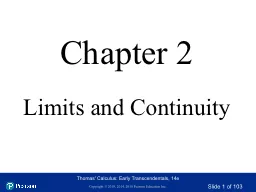PPT-Extending the Limits of
Author : pamella-moone | Published Date : 2016-08-08
Tranctability CS3230R Presentation Introduction We have studied many efficient techniques for solving problems such as divide and conquer greedy algorithm dynamic
Presentation Embed Code
Download Presentation
Download Presentation The PPT/PDF document "Extending the Limits of" is the property of its rightful owner. Permission is granted to download and print the materials on this website for personal, non-commercial use only, and to display it on your personal computer provided you do not modify the materials and that you retain all copyright notices contained in the materials. By downloading content from our website, you accept the terms of this agreement.
Extending the Limits of: Transcript
Download Rules Of Document
"Extending the Limits of"The content belongs to its owner. You may download and print it for personal use, without modification, and keep all copyright notices. By downloading, you agree to these terms.
Related Documents














